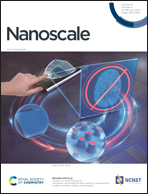Hierarchical structure promoted lithiation/delithiation behavior of a double-carbon microsphere supported nano-Co3O4 anode†
Abstract
Due to limited mass loading, high-capacity electrode materials such as transition metal oxides (TMOs) are essential for microscale Li-ion batteries (LIBs) integrated in nano-/micro-electromechanical systems (N/MEMS). Unfortunately, their electrochemical performances are largely plagued by severe mechanical degradation and slow electron transport. Therefore, it is crucial to develop strategies that can improve the structural stability and electronic conductivity of TMO electrodes. In this work, double-carbon (carbon nanotubes and ketjen black) microsphere (DCMS) supported Co3O4 electrodes are fabricated simply through a spray drying and solvothermal method, which are designed to have a mesoporous three-dimensional (3D) hierarchical heterostructure containing well-dispersed Co3O4 nanoparticles within the DCMS framework. An in situ transmission electron microscopy (TEM) study reveals that the DCMS framework can not only provide facile strain accommodation, but also good electronic conductivity, leading to a much improved Li-storage performance compared to other Co3O4-based anodes. The hierarchical electrode exhibits maximum charge capacities of 1205.2 and 678.1 mA h g−1 at current densities of 0.1 and 2 A g−1, respectively, as well as a capacity retention of 92.2% at 0.3 A g−1 after 100 cycles. This study provides a low-cost, simple and general method for developing advanced high-capacity electrodes.



 Please wait while we load your content...
Please wait while we load your content...